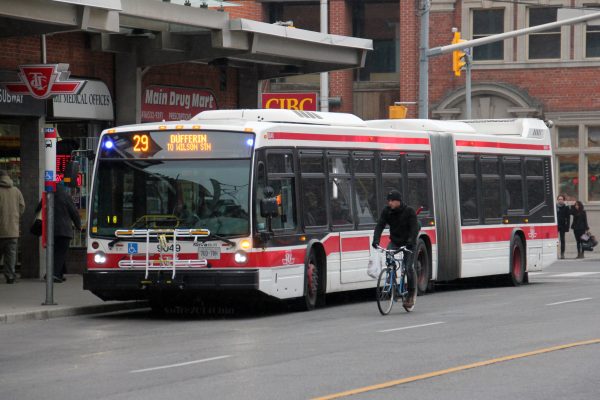Sean Marshall is a Toronto planner, transit advocate, and long-time Spacing contributor. This is cross-posted from his personal web site.
While most people are urged to stay home as much as possible during the ongoing COVID-19 pandemic, there are those who must carry on. These include health care workers, staff at grocery stores, pharmacies, and other essential businesses, and others who can not work from home. There are also those who continue to require transit to undertake essential errands, such as medical appointments.
Thankfully, most transit systems have carried on. Through GO Transit has experienced an 80% drop in ridership since the beginning of March, it continues to operate all rail lines and most bus routes, providing fewer trips, but maintaining the same span of service hours. The TTC discontinued most express routes, but it maintains a grid of frequent bus and streetcar services.
However, the TTC and Brampton Transit continue to struggle with crowding on certain routes. Brampton Transit — which has resorted to an “enhanced Saturday service” level – will only carry half a bus’s seated capacity to enforce social distancing, which has resulted in “closed-door” situations where buses won’t stop for waiting passengers. As a result, several routes are now discontinued during peak periods so that buses are sent to address crowding elsewhere. Brampton Transit serves many shipping warehouses, including two Amazon fulfillment centres, which remain busy during this time. Similarly, the TTC has also reduced its loading standards to ensure that staff and customers are able to remain safe.
However, the TTC is struggling with morning rush hour crowding on ten bus routes:
- 29 Dufferin
- 35 Jane
- 41 Keele
- 44 Kipling South
- 96 Wilson
-
102 Markham Road
- 117 Alness-Chesswood
- 119 Torbarrie
- 123 Sherway
-
165 Weston Rd North
These routes, mostly clustered in the city’s northwest, are illustrated below.

Routes 117 and 119 are industrial services, connecting warehouses and food service plants. These industries — like the infamous Fiera Foods plants served by Route 119 — rely on low-paid, often temporary workers, with early morning starts. Certain warehouses and many food-service plants also have very early starts to the day. It would be tough for workers to accommodate the TTC’s request to travel at later times. Routes 96, 102, and 165 also extend into major industrial areas. Route 123 serves the Metro supermarket chain’s distribution centres on Dundas Street and The West Mall.
Many of these routes run through Toronto’s neighbourhood improvement areas, which are identified by the city as those requiring additional investment due to issues such as poor access to services and higher concentrations of low-income families. In addition, routes 41, 96, 119, and 165 serve the Humber River Regional Hospital, one of Toronto’s largest health care facilities, while the 96 Wilson also directly serves Etobicoke General Hospital.
Though it would be best for private essential employers to stagger shifts during this unprecedented time, the TTC has since recognized that is not an option for many employees. On April 1, the TTC announced that an additional 47 buses are now added to those routes — as well as the 300 and 320 night buses and the 52 Lawrence West to the Airport — to meet the demand while ensuring the safety of its customers.




